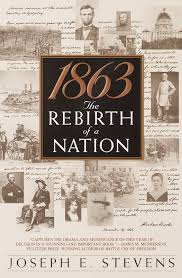
Joseph Stevens is not only a gifted writer, he is also a clear-thinking and acute observer of the American landscape. He is a craftsman in the use of words, an author who uses the written word as Monet used palette and brush, a literary stylist of the first degree. A former work of his, Hoover Dam: An American Adventure, garnered three esteemed awards. In a previous instance of his recognition of recent national crazes, he wrote America’s National Battlefield Parks: A Guide.
The only fault I could find with Stevens regarding 1863: The Rebirth of a Nation is that he, rather than I, had the idea and did something with it. In the past, I had considered the possibility of comparing the year 1863 with 1776 in terms of each year’s relative importance to the achievement of personal liberty and democratic government in the United States. The potential areas of comparison include: the Declaration of Independence as the charter of American nationhood and autonomy in 1776, and the Emancipation Proclamation as the birth certificate of African-American freedom in 1863; the Fourth of July as the date American independence was announced in 1776, and also the date that Robert E. Lee withdrew from Gettysburg and Ulysses S. Grant accepted the surrender of the Confederate garrison at Vicksburg, Mississippi; the improbable Christmas Eve victory of George Washington and his tattered force at Trenton, New Jersey, after having crossed the Delaware River, and the unlikely attack of the Army of the Cumberland up Missionary Ridge on November 25, 1863, that carried that virtually unassailable position and drove the Confederates out of eastern Tennessee for good.
The theme that 1863 was a year unrivaled or at least unsurpassed in importance in American history was so tempting and so available that it led me to wonder why nobody had explored the subject. Now Stevens has, and his book is marvelous. Reviewing events of 1863 in a parallel manner, first discussing Northern political and military events, and then providing a description and assessment of contemporaneous occurrences in the South, Stevens provides a captivating crescendo toward what proves to be the penultimate year of the war, 1864, when the final verdicts on Southern independence, slavery, and the state of the American Union as it prepared to enter the 20th century would be determined on hundreds of battlefields and in thousands of polling places.
Stevens’s prologue takes the reader into the Union War Department’s telegraph office with President Abraham Lincoln as he prepares his monumental Annual Message (later to be known as the State of the Union Address) that will be read to the U.S. Congress in early December 1862, the first state paper from Lincoln since making a preliminary announcement for the Emancipation Proclamation the previous September. What Lincoln wrote needed to be persuasive, and he knew it. Yet with a scarcity of good news from the battlefield, he had little to serve as a cloak of glory to drape around his most important (and controversial) presidential undertaking. Stevens describes the agonizing dilemma Lincoln faced. Though he preferred “to cut to the heart of an issue whenever possible,” the Annual Message required him to include formal reports on his activities along with his personal remarks. “It was a cumbersome combination,” Stevens writes, “but custom and the dictates of the Constitution required it.”
The second part of the prologue concerns Jefferson Davis during the same period. Here, Stevens visits the Confederate president as he stands at the podium of Representatives’ Hall in Jackson, Mississippi, and attempts to encourage the leaders of his own state who face desperate straits as they prepare to fight for their independence against Yankee armies led by determined officers. As difficult as Lincoln’s task would be in December 1862, Davis would be required to perform miracles. Stevens provides a background of the political and military situation that will assist in understanding Davis’s address that day, and then writes: “He launched into his peroration now, speaking calmly, almost serenely, letting his voice envelop the audience it its warm, reassuring folds. He believed that the war was approaching its climax; that the battles of 1863 would be decisive. And despite the crisis here in the West, he was sure that the Confederacy was going to prevail….”
Stevens divides the year 1863 into seasons, and devotes to each four or five chapters of detailed description of critical military and political events and places. There are visits into the headquarters tents and front parlors of the people who made those events important. Juxtaposing the respective capitals, Washington and Richmond, with the battlefields and the military commanders, Stevens makes historical truth read more like a best-selling novel. His book is accurate, interesting, and full of intelligent and useful analysis. It contains colorful and descriptive anecdotes that will appeal to anyone interested in the people and events of the Civil War era. It is one of the finest works on the period in recent years. Here is an ovation for Joseph Stevens, and a hearty welcome to the arena of Civil War scholarship. His contributions to this highly competitive field will be outstanding.
David E. Long
East Carolina University




